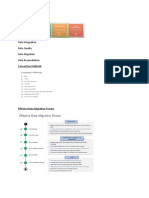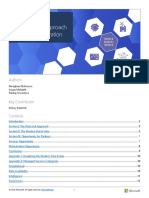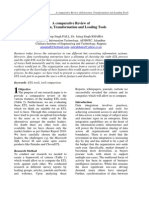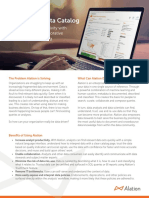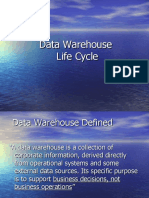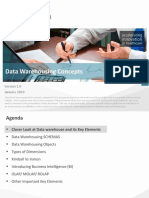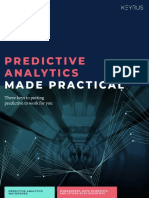Approach Your Data with a Product Mindset Page 1 of 8
PRODUCT DEVELOPMENT
Approach Your Data with a
Product Mindset
by Jedd Davis , Dave Nussbaum and Kevin Troyanos
May 12, 2020
Jorg Greuel/Getty Images
According to an International Data Corporation (IDC) report, at least half of global
GDP will be digitized by 2021. Unfortunately, as the report explains, “While most
organizations are attempting [digital transformation], only a small percentage are getting
it right.”
https://hbr.org/2020/05/approach-your-data-with-a-product-mindset?utm_medium=email&... 5/25/2020
�Approach Your Data with a Product Mindset Page 2 of 8
In most cases, the tech isn’t the problem. Many organizations’ failure to adapt to a
highly digitized business landscape stems from their inability to convince employees to
embrace data-driven decision-making. A NewVantage Partners survey found that 48%
of executives cite “people challenges” as the foremost barrier to being more data-driven
as an organization, compared to just 19% who cite “technology.” As such, while a well-
equipped analytics team is a necessary condition of using data to drive business value,
organizations need to look beyond building a team of skilled data professionals with the
latest analytics tools and technologies if they want to leverage data to improve their day-
to-day operations.
To more actively contribute to the achievement of critical business outcomes, analytics
teams should start viewing their random forests and neural networks through a product
development lens. By bringing a product development approach to the planning and
execution of analytics, organizations can scale isolated successes into the kind of
sustained, organization-wide, data-driven decision-making that serves as the foundation
of genuine digital transformation.
Using Analytics Solutions to Address Unmet Needs
Adoption is the key metric of product development, and as such, identifying — and
addressing — end users’ unmet needs is a central imperative of nearly every product
development methodology. Acting on this imperative requires analytics professionals to
take a step outside their comfort zones and assume more collaborative roles than they
are accustomed to.
INSIGHT CENTER Instead of independently developing a new
Data & Digital Transformation method of performance measurement or a
Best practices for putting data to work. new algorithm for automated customer
segmentation, analytics professionals
should start by asking their colleagues in
https://hbr.org/2020/05/approach-your-data-with-a-product-mindset?utm_medium=email&... 5/25/2020
�Approach Your Data with a Product Mindset Page 3 of 8
each department, “What key business questions are you trying to answer?” and, “What
outcomes are you trying to achieve?” A marketing team might be trying to solve for
something different than an IT team, which might be trying to solve for something
different than an executive team. Each of these teams is only going to adopt an analytics
solution if it solves for its own unique problems, so an analytics team must conduct
extensive stakeholder interviews to develop a clear understanding of the diversity of
unmet needs across its organization.
Only after it has gathered all these unmet needs should an analytics team determine
which datasets and analytical techniques it will use to develop effective point solutions.
That said, agility and iterability are also central imperatives of product development,
and analytics teams should treat them as such — nothing about data necessitates a
plodding, epochal approach.
As an example, imagine you’re a data professional at a major retailer that’s trying to
navigate the disruption caused by the COVID-19 pandemic. If you ask your Director of
e-Commerce, “What key business questions are you trying to answer?” their answer is
unlikely to involve insufficient traffic — the tragic circumstances of the pandemic have
forced an inordinate number of shoppers online. They might, however, note that many
circumstantial online shoppers have a low propensity for engaging with information-
capture mechanisms like newsletters or “secret discount offers.” As such, your directive
might be to analyze these shoppers’ online behaviors to figure out the best way for the
e-commerce team to capture some information that could be used to increase the
shoppers’ customer lifetime value.
At the same time, your EVP of Store Sales is likely to offer a dramatically different
answer to, “What key business questions are you trying to answer?” With most of their
stores temporarily shuttered, their most pressing problems might be figuring out how to
adjust their inventory management in a way that supports the sudden shift to
https://hbr.org/2020/05/approach-your-data-with-a-product-mindset?utm_medium=email&... 5/25/2020
�Approach Your Data with a Product Mindset Page 4 of 8
e-commerce-only operations and how to minimize friction for traditionally brick-and-
mortar shoppers as they transition to online shopping. These problems require entirely
different analytics solutions than the Director of e-Commerce’s problem.
Their differences notwithstanding, each of these analytics solutions must be prototyped
and iterated on quickly to ensure the ongoing viability of your business. This is where
applying the kind of agile product development methodology commonly used in
software development becomes invaluable. In a high-pressure, high-volatility business
situation like the one precipitated by COVID-19, you need to deliver a new information-
capture mechanism to your Director of e-Commerce and new inventory management
guidelines to your EVP of Store Sales in no more than a week or two. Your best bet is to
develop some sort of analytics solutions to put into play immediately, observe how
they’re received by both internal and external stakeholders, and iterate as necessary.
Moving from Analytics Solutions to Analytics Products
The example above illustrates how a retailer might bring a product development
approach to the creation of analytics solutions, but it doesn’t cover the creation of full-
fledged analytics products. Your new information-capture mechanism and inventory
management guidelines might prove to be tremendously effective, but they’re only
point solutions — solutions to highly specific business problems.
Productization involves abstracting the underlying principles of successful point
solutions until they can be used to solve an array of similar, but distinct, business
problems. Here’s how this might play out in the context of our example:
• After confirming the effectiveness of your point solutions, you consider how the
analytical techniques at their core could be used to solve additional problems for the
same teams and/or problems for other teams.
• This consideration leads to two discoveries:
https://hbr.org/2020/05/approach-your-data-with-a-product-mindset?utm_medium=email&... 5/25/2020
�Approach Your Data with a Product Mindset Page 5 of 8
◦ The analytics at the root of your new information-capture mechanism could be
tweaked and repurposed by your marketing team to drive loyalty program sign-
ups.
◦ The analytics at the root of your new inventory management guidelines could be
tweaked and repurposed by your product planning team to reduce the number of
items that sell poorly and end up on clearance.
As these kinds of discoveries accumulate, full-fledged analytics products begin to take
shape — products that can do much of the legwork of dismantling organizational silos.
Discoveries in the first vein might lead to a product that can be utilized to drive
customer engagement in a wide variety of circumstances. Discoveries in the second vein
might lead to a product that can be utilized for resource optimization across your
company’s departments — marketing, sales, technology, etc. These products’ settings
and source data will vary depending on the context, but they’re fundamentally
consistent (though not necessarily entirely static) packages of analytics tools and
techniques.
Getting Digital Transformation Right
Developing a robust portfolio of analytics products is an essential component of moving
toward sustained, organization-wide, data-driven decision-making. But, as alluded to
above, fostering the adoption of these products is equally essential — it’s difficult to
characterize a product no one uses as a success.
Adoption hinges not only on the extent to which analytics products are calibrated to
address unmet needs, but on the way the products are packaged and presented. It’s
unusual to think about analytics as anything other than massive spreadsheets and
incomprehensible algorithms, but true productization involves taking the target end
users into account.
https://hbr.org/2020/05/approach-your-data-with-a-product-mindset?utm_medium=email&... 5/25/2020
�Approach Your Data with a Product Mindset Page 6 of 8
A brand manager at your retail company would struggle to identify — let alone use —
an unnamed suite of abstracted analytics point solutions, but they could easily use your
company’s prepackaged, internally branded Customer Engagement Platform. Simply
put, easily identifiable analytics products that offer out-of-the-box functionality in a
variety of business contexts are the key to driving data-driven decision-making across
an organization.
Ultimately, digital transformation isn’t a matter of purchasing a 1,000-user license for a
popular business intelligence or data visualization tool and encouraging employees to
use it, nor is it a matter of giving an analytics team free rein to do whatever it wishes in
a silo. It’s a matter of identifying each team’s unmet needs, developing analytics point
solutions that address these needs, abstracting these solutions into analytics products
that can be used to address additional needs down the line, and packaging these
products in a way that drives adoption by stakeholders across the organization.
This product-oriented approach to analytics breaks down team silos through the Agile
development process, promotes internal technological innovation, and maximizes the
number of employees who actively use data to inform their day-to-day work. It could be
deployed just as easily by a pharmacy retailer attempting to accommodate the
skyrocketing demand driven by the COVID-19 pandemic as by an apparel retailer
attempting to adapt to a sudden pivot to online-only operations. It could be used to see
an organization through a time of crisis just as easily as it could be used to optimize
operations in a time of calm. In short, irrespective of the contextual particulars, it lays
the groundwork for organizations of all kinds to leverage data to achieve critical
business outcomes.
https://hbr.org/2020/05/approach-your-data-with-a-product-mindset?utm_medium=email&... 5/25/2020
�Approach Your Data with a Product Mindset Page 7 of 8
Jedd Davis is the chief product officer at Publicis Health.
Dave Nussbaum is the chief data officer at Publicis Health.
Kevin Troyanos is head of analytics at Publicis Health.
This article is about PRODUCT DEVELOPMENT
Follow This Topic
Related Topics: Analytics
Comments
Leave a Comment
Post Comment
2 COMMENTS
Robert Joseph 12 days ago
Hmm, as a Data Scientist and the former Director of a Fortune 500 Manufacturing company I see
the personnel problem as two-fold. One getting Data Scientist to think through the entire
process to the end user's usage of the solution and two the end-user being more data science
savvy. This meeting of the mind helps the entire company speak a common language. With the
right 1.5 hour course you can change a non-data person to one that can understand the use of
data and how data science can apply to a business issue.
Reply 10
https://hbr.org/2020/05/approach-your-data-with-a-product-mindset?utm_medium=email&... 5/25/2020
�Approach Your Data with a Product Mindset Page 8 of 8
Join The Conversation
POSTING GUIDELINES
We hope the conversations that take place on HBR.org will be energetic, constructive, and thought-provoking. To
comment, readers must sign in or register. And to ensure the quality of the discussion, our moderating team will review
all comments and may edit them for clarity, length, and relevance. Comments that are overly promotional, mean-spirited,
or off-topic may be deleted per the moderators' judgment. All postings become the property of Harvard Business
Publishing.
https://hbr.org/2020/05/approach-your-data-with-a-product-mindset?utm_medium=email&... 5/25/2020


